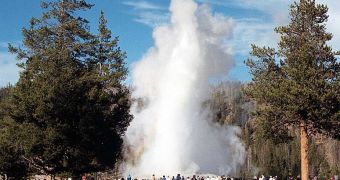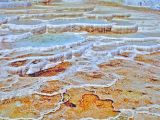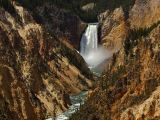In March 1, 1872, the Congress of the United States created the first National Park in the world, which later became the symbol of nature protection in North America and all over the world. The zone had been explored for the first time just two years before, in 1870, by the expedition led by the general Washburn, even if the area had been signaled even from 1807 by John Colter, member of the expedition led by Lewis and Clark and by numerous hunters, which were considered liars!...
The Yellowstone National Park occupies the homonym plateau in northwestern US, surrounded by the Rocky Mountains and it has a surface of 5,470 square km (2,000 square mi). It is a high volcanic plateau, with an average height of 2,400 m (8,000 ft) and some mountainous massives, the tallest being Eagle Peak, 3,468 m (11,560 ft) in the south and Electric Peak, 3,353 m (11,170 m) in the northwestern part. The plateau is totally surrounded by mountainous chains, like Snow Mountains in the north, Teton Range in the south, Absaroka Range in the east. Yellowstone experienced 3 active volcanic periods, which started 2.1 million years.
Yellowstone stretches on the territories of 3 states: Wyoming (90 %), Montana and Idaho. There are 5 entrances into the park crossed by the parallel of 45o N.
The oldest human traces in Yellowstone are 12,000 years old and during the 19th century, the territory was inhabited by the Minnetaree and Bannock Indians.
In Yellowstone, the view is amazing and extremely varied: tall peaks, forested slopes, plateaus covered by pastures, others with a moon-like landscape (like Pitchstone Plateau), canyons, waterfalls, rivers, lakes, mineral springs, thermal springs, geysers, petrified forests, muddy volcanoes, plus a rich flora and fauna. 80 % of the park's surface is covered by forests, mainly coniferous, but also 800 species of plants grow here. The geothermal phenomena make Yellowstone famous.
1. What makes Yellowstone most special are its geysers, hot artesian springs. This is the largest geyser field in the world! The second largest in the world, found in Kamchatka (Russia) is much smaller. Yellowstone has about 500 geysers: half of the all geysers in the world! And 300 are really spectacular. The most famous are the Old Faithful, with extremely precise eruptions; Giant Geyser, the largest in the world (it pushes water up to 61 m (203 ft)); Lone Star Geyser, Norris Geyser, Lowe Geyser, Midway Geyser, Upper Geyser, West Thumb Geyser, Heart Lake Geyser, Shoshone Geyser and others. The oldest geyser in Yellowstone is considered the Castle Geyser.
2. But the number of thermal springs in Yellowstone is much larger: about 10,000! The most remarkable is Mammoth Hot Spring, with waters at 78o C, which flows over a succession of terraces with garden aspect due to the rich lime concretions (called travertine). The thermal spring depose over the rocks carbonates, silicates, sulphates, sulfur and other chemicals which over centuries wrap the them with a shield of marble or alabaster, extremely bright in the sunshine, forming natural "palaces", like Cleopatra's Spring, Minerva's Well, Devil's Spring, Jupiter's Balance, Minerva's Terrace. Some are made of volcanic glass (obsidian).
3. Another spectacular phenomenon in Yellowstone are the muddy volcanoes: they are eruption of gases released by hydrocarbons layers deep beneath, which train water and mud on their way to the Earth's surface. So, they have nothing to do with real volcanoes. The noise of a "mud eruption" can be heard 1 km (0.6 mi) away. This is an extremely rare phenomenon on the world.
4. The Amethyst Mountain, in the northwestern corner of the park is a vertical section of 600 m (2,000 ft) in the rock, offering the occasion to see 12 successive fossil forests, covered by volcanic dust. During the ancient volcanic eruption, the organic matter was replaced by minerals. The trunks, and sometimes even roots, got petrified. Between volcanic eruptions, new forest grew over the petrified ones, and with each volcanic eruption a new forest was petrified.
5. Yellowstone is also the place from where three big rivers well: Missouri (4,740 km or 2,962 mi), Snake River (1,670 km or 1,004 mi), and Yellowstone River ( 1,600 km or 1,000 mi). They form spectacular waterfalls, the most important being Yellowstone Falls, the Upper Falls being 33 m (110 ft) tall and the Lower Falls being 93 m (310 ft) tall, on the river with the same name. Yellowstone River also form an impressing canyon, Grand Canyon, 360 m (1,200 ft) tall, 32 km (20 mi) long and 450-1,200 m (1,500-4,000 ft) wide, with slopes in many colors and with many wonderful views. It is 10,000 years old and carved in rhyolite, an fine acid volcanic rock.
The lakes are concentrated in southern part of the park, the largest being Yellowstone Lake, with a surface of 361 square kilometers (141 square miles), a length of the shores of 176 km (110 mi), being located at an altitude of 2,315 m (7,700 ft).
6. Yellowstone harbors the most diverse megafauna in North America: elks, bisons, black bears, grizzly bears, wolves, coyotes, American antelopes and deer. The avifauna includes the bald eagle, pelicans and cormorants. The waters are populated especially with trout.
Tourists who want to see all these beauties have 640 km (400 mi) of roads and 1,920 km (1,200 mi) of tourist paths at their disposal.

 14 DAY TRIAL //
14 DAY TRIAL // 

